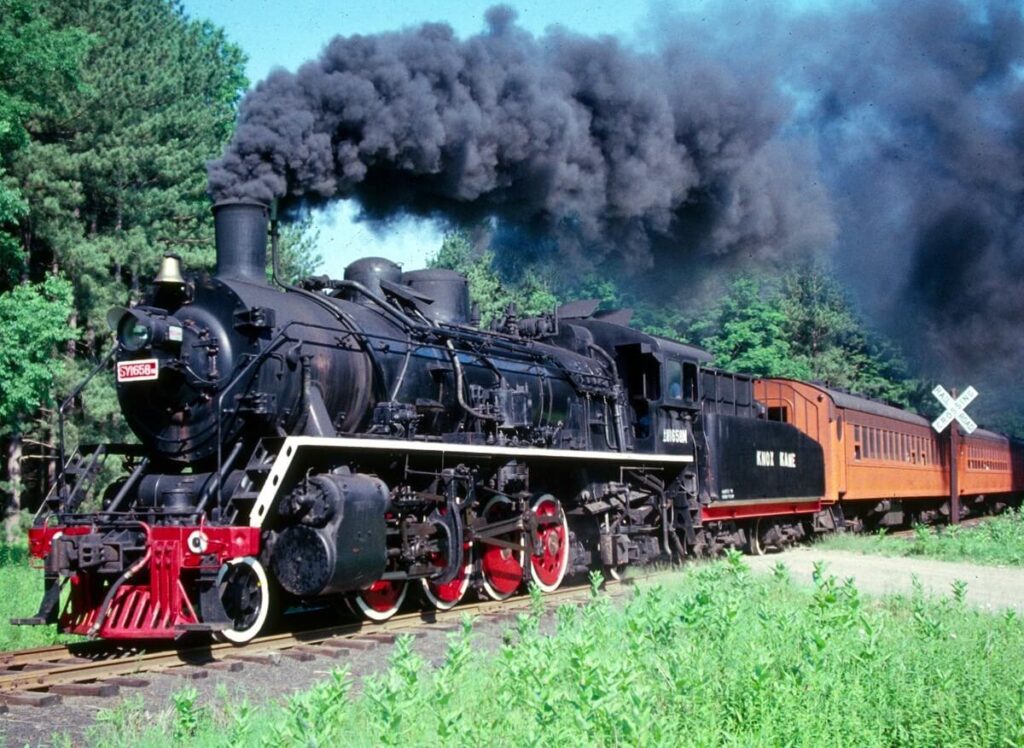Heritage
Heritage
The Kinzua Bridge, also known as the Kinzua Viaduct, was once a towering railroad trestle spanning the Kinzua Creek in McKean County, Pennsylvania. At 301 feet tall and 2,052 feet long, it was hailed as the “Eighth Wonder of the World” when it was completed in 1882. Originally built to transfer freight across the Kinzua Valley, the bridge quickly became a destination for special excursion passenger trains on the Erie Railroad, offering spectacular views and thrilling rides.
Despite its initial success, the bridge’s use dwindled over the years. By 1959, the line across the Kinzua Bridge was abandoned, and the once bustling structure stood silent, its tracks removed. For nearly three decades, the bridge was a relic of a bygone era, isolated and quiet.

In 1987, after 28 years of inactivity, the Knox and Kane Railroad resumed excursion trains across the Kinzua Bridge. This revival was the brainchild of Sloan Cornell, a passionate rail enthusiast and owner of the Knox and Kane Railroad. His vision was to reconnect the historic bridge with the public, offering a unique and nostalgic experience.
The Knox and Kane Railroad, a tourist excursion line, spanned 97 miles through the scenic Allegheny National Forest. Cornell’s dedication and the professionalism of his staff turned the Knox and Kane Railroad into a beloved attraction. In 1986, Cornell secured a 35-year lease to use and operate the Kinzua Bridge, and after ensuring its safety and laying new track, the bridge saw its first excursion train cross in August 1987.
The inaugural run was a momentous occasion. A five-car VIP special, led by locomotive number 38, crossed the bridge on a sunny day, marking the beginning of a new chapter for the Kinzua Bridge. The railroad offered daily excursions, including the popular fall trips that allowed passengers to enjoy the stunning autumn foliage from the heights of the bridge.

Despite its success, the Knox and Kane Railroad faced significant challenges. In 2002, state inspectors closed the bridge due to concerns about corrosion. Efforts to repair and restore the bridge began but were cut short when an F1 tornado struck in July 2003, causing a large portion of the bridge to collapse. The state of Pennsylvania ultimately decided against rebuilding the bridge, opting instead to construct the Kinzua Skywalk, a viewing platform opened in 2011.
The final blow to the Knox and Kane Railroad came in 2008 when an arson fire destroyed the railroad’s locomotives and several coaches. This tragic event led to the railroad’s closure and the auctioning of its assets. The Kovalchick Corporation, a salvage company, purchased the railroad’s property and began removing the tracks.
Today, the legacy of the Knox and Kane Railroad and the Kinzua Bridge lives on through the Kinzua Skywalk and the stories of those who experienced the unforgettable excursions. The Kinzua Bridge State Park remains a testament to the region’s rich railroading history, attracting visitors from around the world to marvel at the remnants of the once-mighty viaduct.

To learn more about the Kinzua Bridge and its storied past, visit the Kinzua Bridge State Park. Explore the Skywalk, enjoy the scenic views, and immerse yourself in the history of one of Pennsylvania’s most iconic landmarks.
For more information, visit the Kinzua Bridge State Park website.
Mikado Productions of Dayton, Ohio proudly presents the tale of the Knox and Kane Railroad and its remarkable journey to revitalize the historic Kinzua Bridge. This story is a testament to the enduring spirit of rail enthusiasts and the power of dreams to breathe new life into forgotten landmarks.
Heritage
During the era of the Great Depression, many young men left school to help support their families. Traditional educational paths were disrupted for countless individuals. The Civilian Conservation Corp (CCC), launched in 1933 as part of President Franklin D. Roosevelt’s New Deal,... Read more
© 2025 Lumber Heritage Region LLC | Website Designed & Hosted by Pixel & Hammer